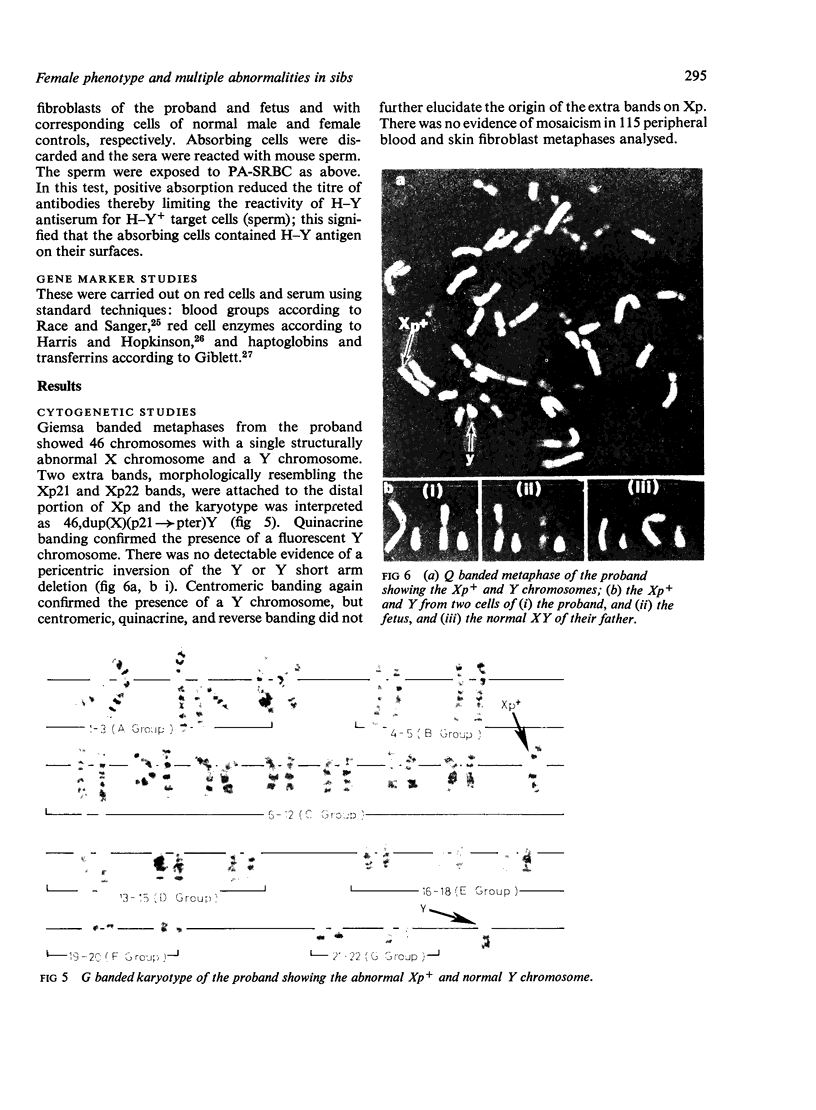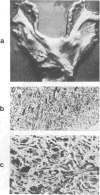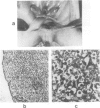Abstract
A mentally retarded female child with multiple congenital abnormalities had an abnormal X chromosome and a Y chromosome; the karyotype was interpreted as 46,dup(X)(p21 leads to pter)Y. Prenatal chromosome studies in a later pregnancy indicated the same chromosomal abnormality in the fetus. The fetus and proband had normal female genitalia and ovarian tissue. H--Y antigen was virtually absent in both sibs, a finding consistent with the view that testis-determining genes of the Y chromosome may be suppressed by regulatory elements of the X. The abnormal X chromosome was present in the mother, the maternal grandmother, and a female sib: all were phenotypically normal and showed the karyotype 46,Xdup(X)(p21 leads to pter) with non-random inactivation of the abnormal X. Anomalous segregation of the Xga allele suggests that the Xg locus was involved in the inactivation process or that crossing-over at meiosis occurred.
Full text
PDF









Images in this article
Selected References
These references are in PubMed. This may not be the complete list of references from this article.
- Bernstein R., Dawson B., Kohl R., Jenkins T. X;15 translocation in a retarded girl: X inactivation pattern and attempt to localise the hexosaminidase A and other loci. J Med Genet. 1979 Aug;16(4):254–262. doi: 10.1136/jmg.16.4.254. [DOI] [PMC free article] [PubMed] [Google Scholar]
- Bernstein R., Wagner J., Isdale J., Nurse G. T., Lane A. B., Jenkins T. X-Y translocation in a retarded phenotypic male. Clinical, cytogenetic, biochemical, and serogenetic studies. J Med Genet. 1978 Dec;15(6):466–474. doi: 10.1136/jmg.15.6.466. [DOI] [PMC free article] [PubMed] [Google Scholar]
- Dewald G. W., Robb R. A., Gordon H. A computer-based videodensitometric system for studying banded human chromosomes illustrated by the analysis of the normal morphology of chromosome 18. Am J Hum Genet. 1977 Jan;29(1):37–51. [PMC free article] [PubMed] [Google Scholar]
- Dutrillaux B., Laurent C., Couturier J., Lejeune J. Coloration des chromosomes humains par l'acridine orange après traitement par le 5 bromodéoxyuridine. C R Acad Sci Hebd Seances Acad Sci D. 1973 Jun 13;276(24):3179–3181. [PubMed] [Google Scholar]
- Ford C. E. Cytogenetics and sex determination in man and mammals. J Biosoc Sci Suppl. 1970 May;2:7–30. doi: 10.1017/s0021932000023427. [DOI] [PubMed] [Google Scholar]
- German J., Simpson J. L., Chaganti R. S., Summitt R. L., Reid L. B., Merkatz I. R. Genetically determined sex-reversal in 46,XY humans. Science. 1978 Oct 6;202(4363):53–56. doi: 10.1126/science.567843. [DOI] [PubMed] [Google Scholar]
- Ghosh S. N., Shah P. N., Gharpure H. M. Absence of H-Y antigen in XY females with dysgenetic gonads. Nature. 1978 Nov 9;276(5684):180–181. doi: 10.1038/276180a0. [DOI] [PubMed] [Google Scholar]
- Goding J. W. The chromic chloride method of coupling antigens to erythrocytes: definition of some important parameters. J Immunol Methods. 1976;10(1):61–66. doi: 10.1016/0022-1759(76)90007-7. [DOI] [PubMed] [Google Scholar]
- Gropp A., Winking H., Frank F., Noack G., Fredga K. Sex-chromosome aberrations in wood lemmings (Myopus schisticolor). Cytogenet Cell Genet. 1976;17(6):343–358. doi: 10.1159/000130737. [DOI] [PubMed] [Google Scholar]
- Jost A. A new look at the mechanisms controlling sex differentiation in mammals. Johns Hopkins Med J. 1972 Jan;130(1):38–53. [PubMed] [Google Scholar]
- Kearney R., Chia E., Basten A. Detection of membrane-associated antigens on lymphoid cells by antibody coupled to staphylococcal protein A. J Immunol. 1975 Apr;114(4):1143–1146. [PubMed] [Google Scholar]
- Koo G. C., Wachtel S. S., Krupen-Brown K., Mittl L. R., Breg W. R., Genel M., Rosenthal I. M., Borgaonkar D. S., Miller A. D., Tantravahi R. Mapping the locus of the H-Y gene on the human Y chromosome. Science. 1977 Dec 2;198(4320):940–942. doi: 10.1126/science.929180. [DOI] [PubMed] [Google Scholar]
- Müller U., Zenzes M. T., Bauknecht T., Wolf U., Siebers J. W., Engel W. Appearance of hCG-receptor after conversion of newborn ovarian cells into testicular structures by H-Y antigen in vitro. Hum Genet. 1978 Dec 18;45(2):203–207. doi: 10.1007/BF00286964. [DOI] [PubMed] [Google Scholar]
- Nagai Y., Ciccarese S., Ohno S. The identification of human H-Y antigen and testicular transformation induced by its interaction with the receptor site of bovine fetal ovarian cells. Differentiation. 1979;13(3):155–164. doi: 10.1111/j.1432-0436.1979.tb01578.x. [DOI] [PubMed] [Google Scholar]
- Ohno S., Nagai Y., Ciccarese S. Testicular cells lysostripped of H-Y antigen organize ovarian follicle-like aggregates. Cytogenet Cell Genet. 1978;20(1-6):351–364. doi: 10.1159/000130863. [DOI] [PubMed] [Google Scholar]
- Priest J. H., Blackston R. D., Au K. S., Ray S. L. Differences in human X isochromosomes. J Med Genet. 1975 Dec;12(4):378–389. doi: 10.1136/jmg.12.4.378. [DOI] [PMC free article] [PubMed] [Google Scholar]
- Rowley J. D. Letter: A new consistent chromosomal abnormality in chronic myelogenous leukaemia identified by quinacrine fluorescence and Giemsa staining. Nature. 1973 Jun 1;243(5405):290–293. doi: 10.1038/243290a0. [DOI] [PubMed] [Google Scholar]
- Silengo M., Kaufman R. L., Kissane J. A 46,XY infant with uterus, dysgenetic gonads and multiple anomalies. Humangenetik. 1974;25(1):65–68. doi: 10.1007/BF00281008. [DOI] [PubMed] [Google Scholar]
- Sumner A. T. A simple technique for demonstrating centromeric heterochromatin. Exp Cell Res. 1972 Nov;75(1):304–306. doi: 10.1016/0014-4827(72)90558-7. [DOI] [PubMed] [Google Scholar]
- Therman E., Patau K. Abnormal X chromosomes in man: origin, behavior and effects. Humangenetik. 1974;25(1):1–16. doi: 10.1007/BF00281002. [DOI] [PubMed] [Google Scholar]
- Verma R. S., Lubs H. A. A simple R banding technic. Am J Hum Genet. 1975 Jan;27(1):110–117. [PMC free article] [PubMed] [Google Scholar]
- Wachtel S. S., Basrur P., Koo G. C. Recessive male-determining genes. Cell. 1978 Sep;15(1):279–281. doi: 10.1016/0092-8674(78)90103-4. [DOI] [PubMed] [Google Scholar]
- Wachtel S. S., Koo G. C., Boyse E. A. Evolutionary conservation of H-Y ('male') antigen. Nature. 1975 Mar 20;254(5497):270–272. doi: 10.1038/254270a0. [DOI] [PubMed] [Google Scholar]
- Wachtel S. S., Koo G. C. H-Y antigen and abnormal sex differentiation. Birth Defects Orig Artic Ser. 1978;14(6C):1–7. [PubMed] [Google Scholar]
- Wachtel S. S., Koo G. C., Ohno S., Gropp A., Dev V. G., Tantravahi R., Miller D. A., Miller O. J. H-Y antigen and the origin of XY female wood lemmings (Myopus schisticolor). Nature. 1976 Dec 16;264(5587):638–639. doi: 10.1038/264638a0. [DOI] [PubMed] [Google Scholar]
- Wachtel S. S., Ohno S. The immunogenetics of sexual development. Prog Med Genet. 1979;3:109–142. [PubMed] [Google Scholar]
- Wilson J. D., Goldstein J. L. Classification of hereditary disorders of sexual development. Birth Defects Orig Artic Ser. 1975;11(4):1–16. [PubMed] [Google Scholar]
- Yunis J. J. High resolution of human chromosomes. Science. 1976 Mar 26;191(4233):1268–1270. doi: 10.1126/science.1257746. [DOI] [PubMed] [Google Scholar]
- Zenzes M. T., Wolf U., Günther E., Engel W. Studies on the function of H-Y antigen: dissociation and reorganization experiments on rat gonadal tissue. Cytogenet Cell Genet. 1978;20(1-6):365–372. doi: 10.1159/000130864. [DOI] [PubMed] [Google Scholar]
- de la Chapelle A., Koo G. C., Wachtel S. S. Recessive sex-determining genes in human XX male syndrome. Cell. 1978 Nov;15(3):837–842. doi: 10.1016/0092-8674(78)90268-4. [DOI] [PubMed] [Google Scholar]










